

CHAPTER XI.
ILLUSTRATIONS OF CENTRAL-POINT, SETTING, PARALLELISM, AND SYMMETRY
Introduction—
Poetic central-point in the climax—
Setting in the digression—
Illustrations—
Parallelism in metaphors and similes—
In what is termed parallelism—
And in lines of verse—
Poetic symmetry, with illustrations—
All three methods in poetic form—
How manifested—
Central-point and setting in music—
Parallelism and musical harmony: illustrations—
Symmetry—
Connection between lines radiating from a central point and appearance of unity and principality in visible objects—
Illustrations from Paintings—
Curved lines of radiation—
Lines of direction in architecture—
The Nature of Setting in the Arts that are seen—
Parallelism and its Connection with Order—
Illustrations from Painting and Sculpture—
How it gives unity to forms associated by way of congruity—
Symmetry: Its Present different from its Former Meaning—
Symmetrical Paintings—
Symmetry, an application of the principle of Complement all the Features of the Two Sides of a Composition—
Connection between Symmetry and Organic Form—
Some Variety not inconsistent with symmetry.
THE methods considered in the last chapter cannot be fully understood, except as we perceive how composition in each art is influenced by them. Thus far they have been treated as if they had to do only, or, at least, mainly, with effects that are visible. This was unavoidable. Primarily, such is the case; and in a general explanation of the methods it was necessary to begin where they begin. But just as consonance and dissonance, which have a primary applicability to the relations of
[The Genesis of Art-Form by G.L. Raymond, chapter XI, page 162]
sound, are used for those of sight, so these, in which the conditions are reversed, are used for those of sound.
Turning first to poetry, the reader will recall how almost every great drama or epic contains passages in which the different incidents illustrating the general plot are made to converge and form what is called the climax; as, for instance, in the fifth acts of “Othello” or “Hamlet”; or in “Macbeth,” where, just after the announcement of the death of Lady Macbeth, the revelation comes to her husband that the prophecies in which he has trusted, such as
All hail, Macbeth, hail to thee, thane of Glamis.
—Macbeth, iii.: Shakespeare
All hail, Macbeth, hail to thee, thane of Cawdor.
—Idem.
All hail, Macbeth, thou shalt be king hereafter.
—Idem.
Be bloody, bold, and resolute; laugh to scorn
The power of man.
—Idem, w., I
and
Macbeth shall never vanquished be until
Great Birnam wood to high Dunsinane hill
Shall come against him.
—Idem, w., I
can all be fulfilled, and yet he can die by the hand of him concerning whom he has also heard the warning,
Macbeth, Macbeth, Macbeth, beware Macduff.
—Idem.
It is impossible for him to draw any other inference after hearing the words of the frightened messenger who
[The Genesis of Art-Form by G.L. Raymond, chapter XI, page 163]
has seen Macduff’s army approaching Dunsinane Castle, hidden behind boughs which they carry, taken from the woods of Birnam:
Messenger. Gracious, my lord,
I should report that which I saw,
But know not how to do it.
Macbeth, Well, say, sir,
Mess. As I did mind my watch upon the hill,
I looked toward Birnam, and, anon, methought
The woods began to move.
Macb. Liar and slave.
Mess. Let me endure your wrath, if ‘t be not so;
Within this three mile you may see it coming;
I say a moving grove.
—Idem.
In nothing is the skill of a great literary artist made so manifest as through the effects he produces by causing all the materials at his disposal to converge thus at a central point. Notice, too, that, in every such case, long before the separate threads of the story are finally brought together, all through the composition, these effects are presented in such a way as to prepare the mind for that to which, for this reason, they may be said to point. It is hardly necessary to add now that these details together constitute what every one recognizes to be a part of the setting, another word for what is familiarly known as elaboration, forming, if it be extended to a connected series of events, a digression. In a well arranged composition, passages containing material of this kind are always kept subordinate to the principal conception, being made, as it were, to circle around this in such a way as to reveal clearly the relationship between them and it. The opening lines of each of the following sonnets, for instance
[The Genesis of Art-Form by G.L. Raymond, chapter XI, page 164]
have to do with the setting; and yet they all have a direct bearing in unfolding that which, in the closing line of each, or, at most, two lines, gives point to the whole:
A rose as fair as ever saw the North,
Grew in a little garden all alone:
A sweeter flower did Nature ne'er put forth,
Nor fairer garden yet was ever known.
The maidens danced about it morn and noon,
And learned bards of it their ditties made;
The nimble fairies by the pale-faced moon
Watered the root and kissed her pretty shade.
But, well-a-day! the gardener careless grew,
The maids and fairies both were kept away,
And in a drought the caterpillars threw
Themselves upon the bud and every spray.
God shield the stock! If heaven send no supplies,
The fairest blossom in the garden dies.
—Sonnet: William Browne.
Could I but grasp the vision, make it mine—
In one full masterly embrace possess
The splendor of my dream, its joy enshrine,
And hold it as some trophy-crown, to bless
With perfect calm and peace the conquest won;
Or could I clear the mist, and fairly face
The high beatitudes of radiant morn,
That reach through infinite degrees of space;
What then—ah, what? The heart would sigh for more;
The longings of a great unrest would send
Swift-winged messengers far on before
Such glory undefined could only lend
A depth to height, a sadness to desire,—
A voice forever calling: “Come up higher.”
—Infinito: Stephen H. Thayer
When I consider how my light is spent
Ere half my day in this dark world and wide,
And that one talent which is death to hide,
Lodged with me useless though my soul more bent
[The Genesis of Art-Form by G.L. Raymond, chapter XI, page 165]
To serve therewith my Maker, and present
My true account, lest he, returning, chide;
“Doth God exact day-labor, light denied?”
I fondly ask. But Patience to prevent
That murmur soon replies: God doth not need
Either man’s work or his own gifts. Who best
Bear his mild yoke, they serve him best. His state
Is kingly. Thousands at his bidding, speed
And post o'er land and ocean without rest;—
They also serve who only stand and wait.
— Sonnet on his Blindness: Milton.
Parallelism means the arrangement of objects on lines equally distant from each other throughout their whole extent, or—what is the same thing—moving in the same direction or on the same plane. What is this in principle but the expressing of the same tendency of thought in different forms, such as we always find in the poetic metaphor or simile? When we compare human life to a river, or the growth of a man to that of a tree, what do we do but illustrate one set of ideas by referring to a second set that move along on a plane parallel to the first?
But the correspondence in poetry to visible parallelism does not pertain entirely to the thought. Certain forms of verse, and these the earliest in existence, those of the Hebrews, have long been designated by this very term. The reason of this is that the verse to which it is applied is made up of a series of statements, two of which, at least, and sometimes more, are parallel, and this both in thought and in style. Here is what is usually considered the most ancient extant verse illustrating this kind of parallelism.
I have slain a man to my wounding,
And a young man to my hurt.
—Genesis w., 23.
[The Genesis of Art-Form by G.L. Raymond, chapter XI, page 166]
And the whole book of the Psalms is characterized by it.
Thy fierce wrath goeth over me;
Thy terrors have cut me off.
They came round about me daily like water;
They compassed me about together.
Lover and friend hast thou put far from me,
And mine acquaintance into darkness.
—Psalm lxxxviii., 16, 17, 18.
It was this method of expressing the same thought in two or three different forms, all of similar length, that eventually led to versification, the sounds of the lines of which, as we hear them read, one after the other, produce an effect of parallelism upon the ear no less marked than the arrangement of them in printed lines does upon the eye.
Symmetry in poetry is an effect of organism in the form almost inseparable from a combination of central-point, setting, and parallelism; and always attendant upon them where all the factors to which they are applied are arranged with due regard for balance. The following two short poems will sufficiently illustrate this effect, and at the same time show, in concrete form, the influence of the other methods. In both poems, as in the sonnets just quoted, the thought centres in the last line, all the setting pointing to that, and attaining full significance only in connection with it; the lines of similar length, often, too, containing expressions of similar import, give us parallelism; and the balanced combination, manifested throughout the whole, results in symmetry.
Here is one leaf reserved for me
From all thy sweet memorials free;
And here my single song might tell
The feelings thou must guess so well.
But could I thus within thy mind
[The Genesis of Art-Form by G.L. Raymond, chapter XI, page 167]
One little vacant corner find
Where no impression yet is seen,
Where no memorial yet has been,
Oh, it should be my sweetest care
To write my name for ever there!
—Verses Written in an Album: Th. Moore.
Because I breathe not love to every one,
Nor do not use set colors for to wear,
Nor nourish special locks of vowed hair,
Nor give each speech a full point of a groan.—
The courtly nymphs, acquainted with the moan
Of those who on their lips Love’s standard bear,
“What! he?” say they of me; “now I dare swear
He cannot love No, no! let him alone.”
And think so still—if Stella know my mind.
Profess, indeed, I do not Cupid’s art;
But you, fair maids, at length this true shall find—
That his right badge is but worn in the heart.
Dumb swains, not clattering pies, do lovers prove,—
They love indeed who quake to say they love.
—Love’s Silence: Sir Ph. Sydney.
Hitherto, central-point, setting, parallelism, and symmetry, as illustrated in poetry, have been very closely assimilated to methods of thought. There is a sense in which, in every art, this treatment of them is inevitable, As indicated a moment ago, to secure unity in connection with an effect upon thought, or congruity, is always their most important function. Moreover, there is a peculiar sense in which this treatment is necessitated in poetry. The factors of its forms are words, and words and thoughts are virtually inseparable. At the same time, they are not entirely so. Words are also forms of sound; and before we pass on, it ought to be shown how the arrangements of them, considered as expressions of thought, are represented, and their effects enhanced, by means of corresponding arrangements
[The Genesis of Art-Form by G.L. Raymond, chapter XI, page 168]
of them considered as sounds. To do this, moreover, will merely carry out the analogy of what has been done already when treating of these methods as applied to visible appearances. It was then shown that central-point, setting, parallelism, and symmetry are illustrated not only in the arrangements of a general view of nature, but of the features of each specific object constituting a part of this view. We have so far considered the application of the methods to a composition considered as a whole. We have now to consider them as applied to separate objects in this whole.
In what sense, then, can it be said that each of the methods under discussion can be fulfilled in forms of sound as they are heard constituting the separate parts of a composition? Let us answer this question, first, as regards central-point. Is there anything in a series of sounds that may be said to point? Certainly—the accents. These have the same influence upon an order of effects heard in succession, as do concentrating lines upon an order of effects seen simultaneously. The accents are like so many radiating lines that, one after another, keep directing attention to the movement—in other words, pointing to it. The unaccented sounds, again, that connect the accented, determining as they do, and as the accents do not, the particular rhythm or metre, whether double or triple, may be said to furnish the form-setting; while the series of lines of verse, called by the same name in this case, correspond exactly, as was said a moment ago, to the series of lines that produce parallelism in the arts of sight. The resulting organic-form of the movement, as secured in the general balance throughout of foot and line, measures the degree of symmetry. These analogies are so evident that they need only to be stated.
[The Genesis of Art-Form by G.L. Raymond, chapter XI, page 169]
Let us pass on now to music. As all will recognize, there is a sense in which every musical composition has its central-point of interest or climax; and there is a sense, too, in which this is accompanied by a setting, consisting of movements elaborated, as it were, independently. In longer compositions (see the theme of Beethoven’s “Symphony No. 5, in C Minor,” printed on page 61), everything is centred in the fundamental melody, from which the whole is developed. Shorter works often have their centre in the key-note or the tonic chord of the principal key. At every critical change of the composition, and almost invariably at its close, the ear requires a suggestion of this theme or key, and, in the return to it, in connection with the various digressions, or, as we may term them, excursions from it, we have conditions analogous, as nearly as anything that is heard can be, to effects produced by central-point and setting as used in the arts that are seen. Often, indeed, in music, both results are attained as in these latter arts, at one and the same time, and thus too, like them, are capable of being represented visibly. Notice once more upon page 6o, the music taken from the variations upon “Old Black Joe.”
Parallelism in music is shown not only in successions of phrases of similar movement, corresponding to successions in poetry of lines of similar metre and length, but also and mainly in the whole constitution of harmony. As every one acquainted with the history of music knows, harmony began with an endeavor to sing, at the same time, two or more different melodies, the tunes of which were found, or made, to be parallel. In modern harmonies, as a rule, there is a distinct melody in only one of the parts, but there is still a sense in which the other tones making up the chords accompanying this, move along on
[The Genesis of Art-Form by G.L. Raymond, chapter XI, page 170]
planes parallel to the melody. The following, in a small way, illustrates all these statements; and, like the music on page 6o, it also does this to the eye almost as effectively as to the ear.
The section marked A illustrates unison, characterized by an absence of harmony; that marked B illustrates parallelism; at C counteracting phrases give a setting to the movements; and at D they are drawn together and made to centre in the chord of the keynote.
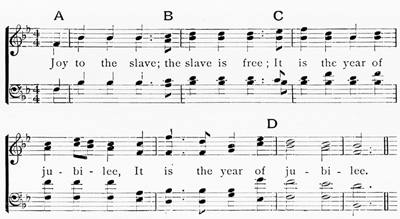
[click here to enlarge image or click here to play music sample]
Symmetry In music, as in poetry, is a result of the general effect of all these other methods when arranged with due regard for balance. This is true, whether applied to a composition as a whole, or to parts of it. Accent, lack of accent, complement, and balance of phrase and period,— these respectively give unity of character to each specific movement, however long or short, in a way exactly analogous to that which is exemplified in the general movement.
The explanation of these methods as applied in the arts of sight was necessarily involved in what was said of them
[The Genesis of Art-Form by G.L. Raymond, chapter XI, page 171]
in Chapter X. We noticed there their origin in nature. It needs to be said now that the artist uses them—not slavishly, merely imitating arrangements which he actually sees in the world about him—but intelligently, applying the principles illustrated in one place to the arrangement of factors which, as observed in another place, do not manifest them. Such a course is frequently the only one enabling him to form an organized whole out of material which, as found in nature, is disorganized. He has noticed the effects of radiation, for instance; so, instead of grouping objects at hap-hazard, or just as he sees them, he rearrange them in such ways that their outlines point toward a principal feature and also to a common centre, thus securing at the same time the effects of principality and of unity.
To illustrate this, the adaptation of the methods of radiation in strict accordance with appearances in the external world, may be noticed in the way in which in Troyon’s “Cattle” (Fig. 50, page 173), the ruts, faintly indicating a road in the foreground, are made to carry the eye backward and concentrate attention upon the centre of the picture occupied by the approaching herd. More artistically, but in just as strict accordance with natural appearances, in Turner's “Decline of Carthage” (Fig. 51, page 175), Corot’s “Canal” (Fig. 47, page 157), and “Landscape with Water” (Fig. 73, page 223), and in Claude’s “Evening” (Fig. 40, page 119), the chief lines, both of contour and of light, are made to converge in the extreme background, and cross and continue themselves in the radiating lines of each picture’s opposite side. A different adaptation of the same method, may be seen in Gerome’s “Pollice Verso” (Fig. 26, page 81). In the centre of this, a gladiator stands with his heel on the neck of a prostrate antagonist, and looks up for a signal to save the life which
[The Genesis of Art-Form by G.L. Raymond, chapter XI, page 172]
is at his mercy. With scarcely an exception, the crowd of spectators, who fill an amphitheatre above, answer this appeal by stretching a hand towards the gladiator, with the thumb downward, indicating thus their desire to have him show no mercy to his fallen antagonist. Of course, all the extended arms, by pointing as they do, direct attention to the gladiator as the principal object of
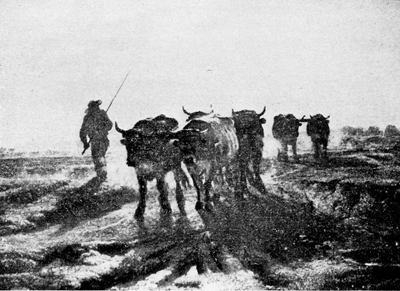 [click here to enlarge image]
[click here to enlarge image]
Fig. 50 – Cattle, by Constant Troyon
(See pages 16, 158, 172)
interest, and also make of the whole picture a unity both in thought and form. But, in addition to this, the horizontal outlines in the front walls of the amphitheatre, which concentrate according to the laws of the perspective, also the outlines of a pillar of the amphitheatre and of one prominent division between its benches, as well, too, as the outlines of a form and the shadow of a gladiator
[The Genesis of Art-Form by G.L. Raymond, chapter XI, page 173]
already slain and lying on the ground,—all these are given such directions that they too point toward the principal figure. The same method is exemplified again in Becker’s “Othello” (Fig. 55, page 181), where the lines formed by a rug on the floor, by the railing of a porch, by a wall, and by the general directions indicated in the tops of buildings seen at a distance, all point toward the object of Othello’s love, Desdemona. A peculiar phase of this effect is mentioned by Ruskin in his “Winkleman’s Ancient Art.” He draws, amid the outlines of Turner’s painting of the “Old Bridge over the Rhine at Coblentz” (see Fig. 66, page 203) five lines not straight but curved. These he continues on from the curved outlines of three boats and of one raft in the rivet, and of the back of a woman sitting on a ledge, and he shows how all the curves lead the eye toward a large tower from which they radiate, and which is the principal figure of the picture. The use of curves for this purpose is illustrated almost equally well in the “Landscape with Water” by Corot, Fig. 73, page 223. Notice in this, how the principal lines bend toward the distant bridge at the right.
When works of sculpture, as in the bas-relief, are composed of many figures, there is no reason why, so far as concerns outline, these effects should not be produced in the same way as in painting. In the “Romans Besieging a German Fortress” (Fig. 6, page 27), but especially in “The Soldier’s Return,” a relief on one side of the famous National Monument on the Rhine near Bingen, familiarly called “The Watch on the Rhine” (Fig. 52, page 176), notice how the lines described by the limbs of the figures on each side of the centre, are made to point, not exactly to the chief figures, but with equal effectiveness toward
[The Genesis of Art-Form by G.L. Raymond, chapter XI, page 174]
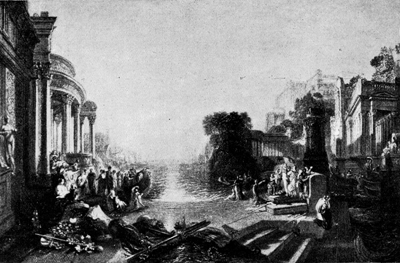 [click here to enlarge image]
[click here to enlarge image]
Fig. 51 – Decline of Carthage, by Joseph Mallord William Turner
(See pages 16, 31, 82, 118, 156, 159, 172, 238.)
[The Genesis of Art-Form by G.L. Raymond, chapter XI, page 175]
them, and as if to an ideal central-point that is above them. A similar effect, but having a more direct bearing upon symmetry in that it directs attention to a central-line rather than point, yet evidently suggested by the way in which limbs radiate from a tree trunk, may be observed in the Vatican statue of a German Captive (Fig. 53, page 177).
In architecture, this method is not used as extensively, perhaps, as it should be. At the same time, there is
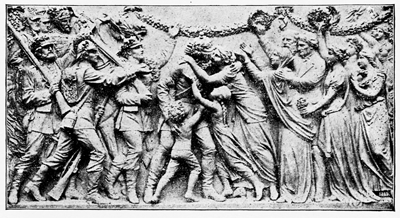 [click here to enlarge image]
[click here to enlarge image]
Fig. 52 – The Soldiers Return (From The National Monument, near Bingen, Germany)
(See pages 16, 26, 174, 182, 257.)
more of it than, at first, might be supposed. Even the laws of the perspective on which it is based were applied by the Greeks to produce effects in buildings in much the same way as we now use them to produce effects in pictures. This fact explains the slight upward curves which have been found toward the middles of the pavements of the porches oil which the columns rested, also the corresponding curves in the entablatures, as well as
[The Genesis of Art-Form by G.L. Raymond, chapter XI, page 176]
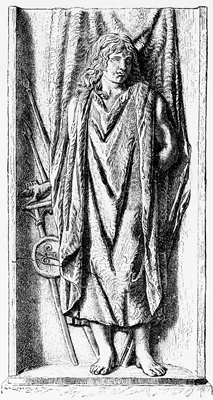 [click here to enlarge image]
[click here to enlarge image]
Fig. 53 – German Captive – Roman Period. (From Statue in The Vatican Museum.)
(See pages 176, 182, 257.)
[The Genesis of Art-Form by G.L. Raymond, chapter XI, page 177]
the narrower spaces left between the columns at the extreme sides, as contrasted with the middles, of the porches, and other variations from exact measurements in other distant, as contrasted with, near, features. Every thing in these buildings was planned so as to produce a desired effect from some supposable view-point. This subject can be treated properly only in connection with proportion. At- present, it is sufficient to notice the evidences in architecture of the same sort of artistic developments from the laws of the perspective that have been noticed in the other arts of sight. Every one must have observed occasionally in connection with mouldings and buttresses, with divisions and cappings of windows and porches, with external and internal arches and ridge-poles of roofs, gables, and ceilings, but especially in connection with the sides of towers and spires, and with innumerable ornamental details, outlines that seem to suggest, at least, a desire to point the thought away to another feature of principal interest with which they are organically connected. Illustrations of these effects, sufficient for the purpose, may be found in the figures given in treating of continuity in Chapter XIV., which see. Undoubtedly it would add to the effects of buildings if more were made of this possibility, as might easily be done by bestowing a little more care upon the arrangements of the necessary lines and arches. Certain it is that, in any art, the mind, in glancing along in the direction to which an outline thus related points, takes pleasure in finding other lines continuing it or converging somewhere with it, and, even without consciousness of the reason, derives from this arrangement impressions both of principality and unity in connection with the whole, which nothing else could give.
[The Genesis of Art-Form by G.L. Raymond, chapter XI, page 178]
The nature of that which in these arts may be called setting will suggest itself almost without illustration. As a rule, the principal features occupy the centre and fore-ground of a painting, and the subordinate features are delegated to its sides and back-ground. This is true, whether applied to groups of figures described about others, or to fringe, robes, trappings, or other ornaments described about single figures. It is the object
 [click here to enlarge image]
[click here to enlarge image]
Fig. 54 – Mithras Stabbing The Bull (Relief in The Louvre.)
(See pages 74, 120, 180, 218.)
of chief interest that occupies the centre; the other objects surround it. Notice Gerome’s “Pollice Verso.” Fig. 26, page 81. Just as the central-point, too, usually has reference to both thought and form, so has the setting. The fringe, robes, trappings, and other ornaments about a king, for instance, are given to him for the purpose both of interpreting and of ornamenting him. Observe the Swan with the “Leda,” Fig. 17, page 74, the armor on the
[The Genesis of Art-Form by G.L. Raymond, chapter XI, page 179]
“Titus,” Fig. 18, page 74, as well as that which fills the background in the “Mithras and the Bull,” Fig. 54, page 179. Setting, when thus properly subordinated, introduces variety and contrast not for its own sake, but for the purpose of adding by way of explanation and offset to that which is of central interest. In painting, either outline or color may be employed in the setting; in sculpture, usually only the former; but the possibilities connected with the adjustments of bands, girdles, drapery, canopies, inches, and, especially in bas-reliefs, of other figures surrounding the principal ones, obviate all practical difficulties in attaining any results that are desirable. In architecture, the method is manifested by the way in which doors, windows, and other individual features are ornamented, usually in connection with their surroundings; and whole buildings also in connection with their foundations, gables, roofs, and towers. A moment's thought will convince us that there is a true sense in which these are all parts of the setting. Notice the doorways in Figs. 95 and 96, pages 289 and 290; also the “Taj Mahal,” Fig. 3, page 19, “St. Mark’s,” Fig. 31, page 88, “St. Sophia,” Fig. 42, page 123, and the “Chateau de Rondeau,” Fig. 85, page 258.
Parallelism is a development of methods of setting, in conformity with the requirements of order, especially of these as manifested in the direction of complement and balance. We all must have observed that while a single line, described by being drawn or worked along the edge of any material, forms a border for it, two or more lines, made parallel to the first, cause the border to appear more satisfactory. A similar effect results from the parallelisms that are seen in the flutings of columns, in the mouldings of picture frames, in the string-courses and cornices of
[The Genesis of Art-Form by G.L. Raymond, chapter XI, page 180]
buildings, as also in the caps and sills of their windows and doors. In the forms of pictures and statues, necessitating, too, in the main a use of widely differing curves, we frequently find the arms and lower limbs, indeed the whole figures and
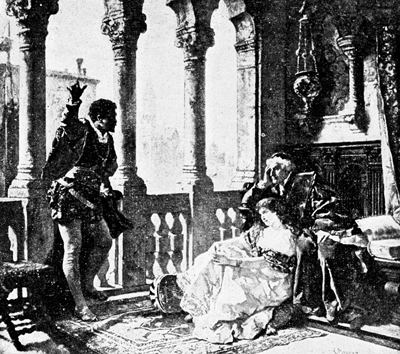 [click here to enlarge image]
[click here to enlarge image]
Fig. 55 – Othello, by Carl Becker
(See pages 72, 174, 181, 239.)
the folds of the drapery about them, as well as the surrounding architectural arrangements of pillars, pilasters, arches, and furniture, all grouped in such a way that their prominent outlines are parallel, or very nearly so. In the original of Becker’s “Othello,” Fig. 55, above, one can count
[The Genesis of Art-Form by G.L. Raymond, chapter XI, page 181]
at the top of the picture forty-two distinctly parallel perpendicular lines, used in the delineations of two distant churches and their domes, the mast of a ship, three pillars of a porch, a swinging lamp, the figure of the Moor, etc. At the right, there are also twenty-two horizontal lines of this kind, found in a rug, a platform, a bench, a mantel-piece, a niche, etc. At the left, are fifteen on the floor extending diagonally, and twenty others formed by a rug and the railing of a porch; while, in at least three cases, three sets of these lines can be detected amid the directions suggested by the limbs and drapery in the group composed of Desdemona and her father. In Gerome’s “Pollice Verso,” Fig. 26, page 81, one can count fifteen parallel horizontal lines, nine of them formed by the architectural work with rugs hung over it, which is in front of the spectators, and six by the bodies of three dead gladiators lying in the arena, apparently without any regard to the requirements of order, just where they have been slain. Besides this, in the same picture, we can count, including all that can be seen in pilasters, pillars, doors, etc., almost sixty of these lines that are perpendicular. Among the figures of the spectators, at least six extended arms are exactly parallel; so is the dirk, the shield, and one leg of the principal figure; and his arm that holds the dirk is exactly parallel to the extended arm of his antagonist who is at his feet. Parallelism is just as evident a characteristic, too, as is central-point, of the sculpture represented in Figs. 52 and 53, pages 176 and 177, and in Fig. 6 of page 27. Notice the same characteristic in the “Dancer” also, Fig. 56, page 183, as well as in the “Laocoon,” Fig. 75 page 226. It may be of interest also to recognize the antiquity of this method, as may be done by a glance at the Chaldean bust now in the British
[The Genesis of Art-Form by G.L. Raymond, chapter XI, page 182]
Museum, inscribed with the name of “Nebo,” Fig. 57, page 184. The effect of all this parallelism, as was indicated on page 151, is to make objects that frequently are only associated by way of congruity, and therefore only ideally alike, seem, nevertheless, to have like directions or tendencies. Moreover, in connection with the other effects of outline, it divides the spaces covered by a composition so that all things put into them appear to be grouped in an orderly way. It may be well to notice, too, that in this it corresponds exactly to the effects of verse and phrase, which in poetry and music, in a similar way, divide up the time.
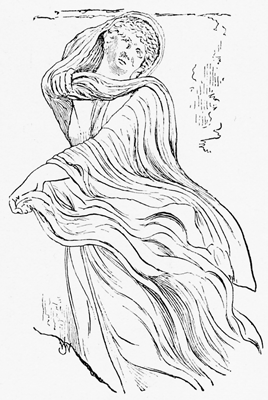 [click here to enlarge image]
[click here to enlarge image]
Fig. 56 – Dancer (From the marble relief discovered in the Theatre of Dionysus.)
(See pages 16, 144, 182, 257.)
Symmetry, as has been said, is a general balance of all the parts of a composition. There can be no such balance when the effects just considered are entirely absent; and when they are present they almost necessarily involve it. But besides this, as applied to visible forms, symmetry seems to suggest especially the idea of an effect produced by balancing pairs of many numbers in an organized body, like that of a man or a horse. This idea is probably
[The Genesis of Art-Form by G.L. Raymond, chapter XI, page 183]
derived by way of association from the former significance of the term, which now it has lost. By symmetry, from σύν and μετρόν, the Greeks meant what we now call proportion, or, as they defined this, a form, all the members of which have a common measure among themselves. Their
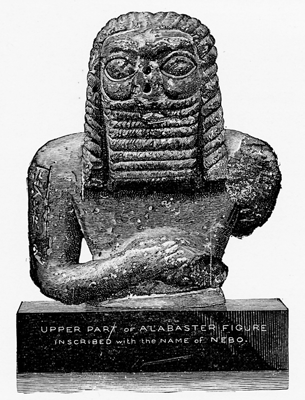 [click here to enlarge image]
[click here to enlarge image]
Fig. 57 – A bust inscribed with the name of Nebo (British Museum.)
(See page 183.)
conception of proportion they derived, primarily, from the measurements of the human figure. But, according to our use of the terms, while a well proportioned form would always be symmetrical, a form like that of a very slim man
[The Genesis of Art-Form by G.L. Raymond, chapter XI, page 184]
might be symmetrical, as far as it went, and yet would not be well proportioned.
Of proportion we cannot speak further here. The term symmetry, as has been said, necessarily involves that of many pairs of balancing features. In this sense, the word symmetrical is applied by way of designation to certain paintings, especially those of the early Italians, in which there are precisely as many figures on one side of the principal figure as on the other side. See the “Lucca Madonna” by Fra Bartolommeo, Fig. 58, on this page.
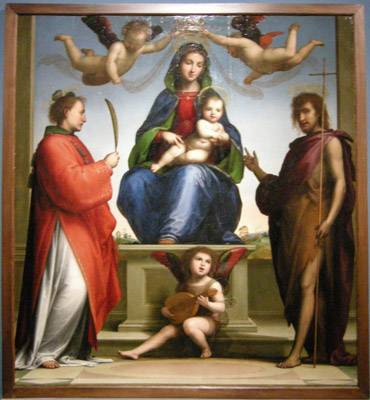 [click here to enlarge image]
[click here to enlarge image]
Fig 58 – Lucca Madonna, by Fra Bartolommeo.
(See pages 72, 185)
photo credit: sailko (Wikimedia Commons)
Symmetry is a term that may be applied, of course, to any develop of complement or balance, as already considered on pages 46 and 84, in the degree in which the principle underlying their effects, whether in the arrangements of equal numbers or like outlines, is applicable to all the features on one side of the middle perpendicular line of a product as compared with all those upon its other side.
[The Genesis of Art-Form by G.L. Raymond, chapter XI, page 185]
The intimate connection, too, already indicated by the arrangement. of the methods on page 131, will be observed here between symmetry and organic form. In fact, all the various methods of grouping the factors of paintings or statues, so as to have the contours of the wholes suggest a circle, an oval, an arch, a pyramid, or a wedge, such as were mentioned on pages 115-118 are almost as much necessitated by the requirements of symmetry as of the method which they are there used to illustrate.
The principle of variety, however, which we find everywhere illustrated in nature and in art, must not be supposed to be entirely inoperative in connection with symmetry. The two sides of even a very symmetrical tree do not exactly correspond, and a tree depicted in art is most apt to have the appearance of life, if the same be true of it.1 The two sides of a man's body are more nearly alike than those of a tree; but in the degree in which he possesses life and consequent grace, they will, while suggesting likeness, be made unlike by the positions which he assumes. Notice Fig. 7, page 30; Fig. 19, page 75; and the “Gladiator” in Fig. 26, page 81. The same must be true to some extent of a building. The slight deviation from exact regularity, owing to the position of the central tower in the “Old Louvre,” Fig. 59, opposite [i.e., facing page], does not interfere with the artistic impressiveness of the castle as a whole. The same is true of the slight lack of exact balance in “Salisbury Cathedral,” Fig. 68, page 207, as well as in “Shadyside Church,” Fig. 34, page 91. As was said on page 87, the dignity of effect demanded in public edifices may sometimes necessitate absolute similarity on both sides of the centre, as in the “Taj Mahal,” Fig. 3 page 19, “St. Peter’s, Rome,” Fig. 23, page 78, “St. Marks, Venice,” Fig. 31, page 88, and “St.
1 Notice floral arrangements in Fig. 49, page 161.
[The Genesis of Art-Form by G.L. Raymond, chapter XI, page 186]
Sophia,” Constantinople, Fig. 42, page 123. Graceful effects, on the contrary, such as are desirable in household architecture, may sometimes be best secured by difference, as in the villas in Figs. 24, page 79, and 28, page
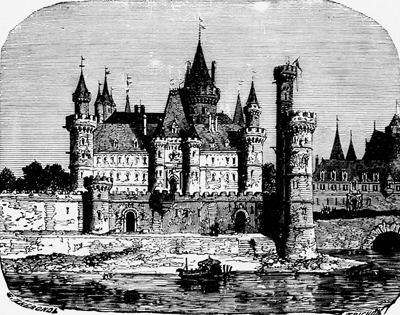 [click here to enlarge image]
[click here to enlarge image]
Fig. 59 – The old Louvre.
(See page 186)
84. But how about a combination of dignity and grace? This is as difficult to attain in art as in life. But when it is attained in either, is there any denying that we have the ideal?
[The Genesis of Art-Form by G.L. Raymond, chapter XI, page 187]